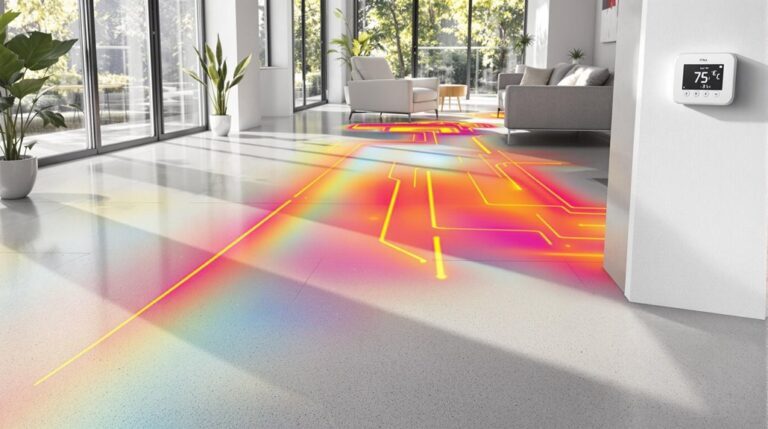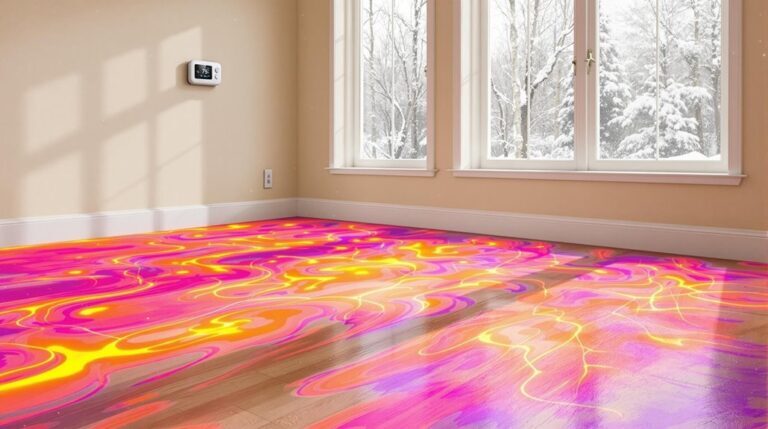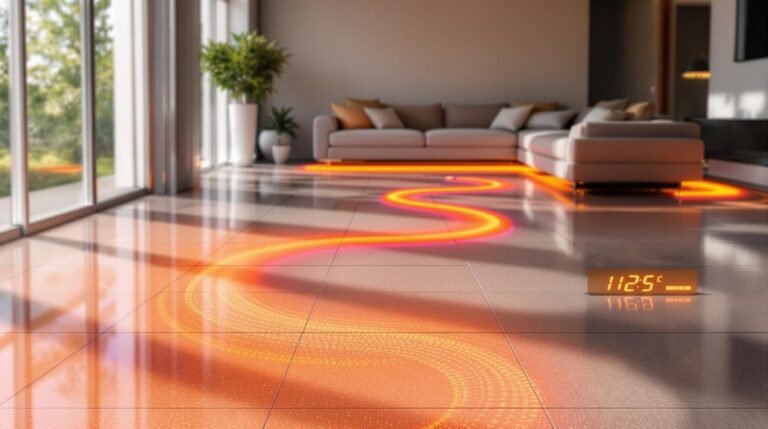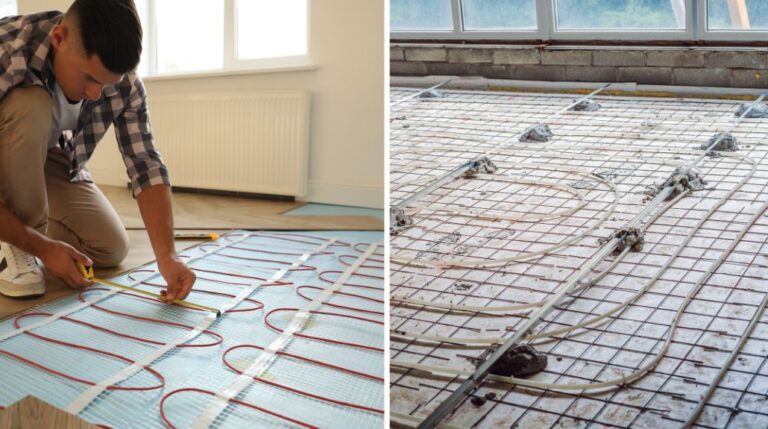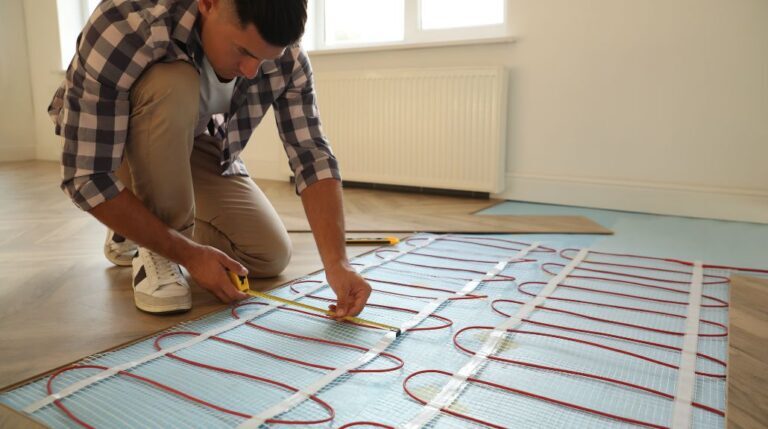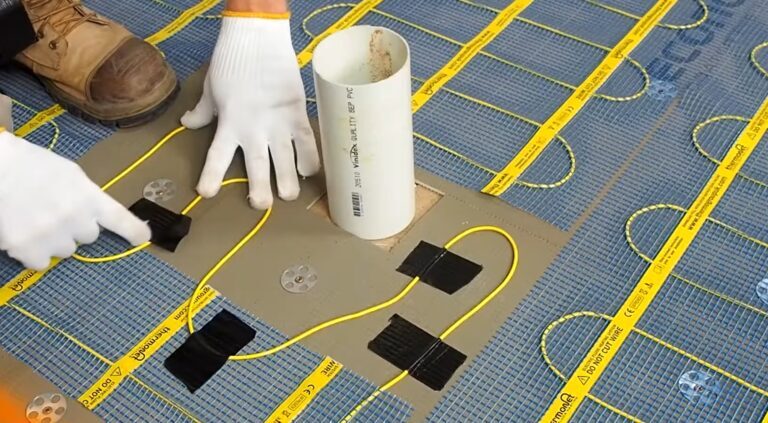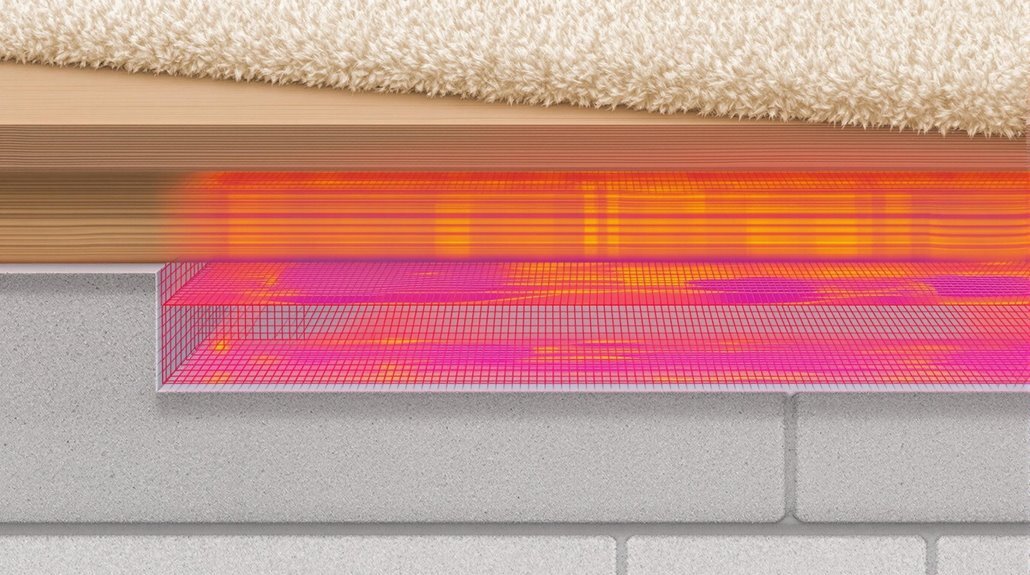
If you’re considering adding rugs to your home with underfloor heating, you’ll need to understand the essential balance between comfort and efficiency. While it’s entirely possible to use rugs with heated floors, making the wrong choice could trap heat, drive up energy costs, or even damage your flooring system. From material selection to placement strategies, several key factors will determine whether your rugs enhance or hinder your home’s heating performance. Let’s explore how you can achieve the perfect blend of warmth and style without compromising your underfloor heating system’s effectiveness.
Key Takeaways
- Yes, rugs can be used with underfloor heating, but they must have a tog rating of 2.5 or less for optimal efficiency.
- Natural fiber rugs like wool are ideal, while synthetic materials should be avoided due to potential melting and reduced heat conductivity.
- Keep rug thickness under 25mm to ensure effective heat transfer and prevent damage to wooden floors underneath.
- Choose smaller area rugs over large ones to promote better heat distribution and airflow around edges.
- Regular maintenance and cleaning are essential to prevent heat retention issues and maintain heating system efficiency.
Best Rug Materials for Underfloor Heating
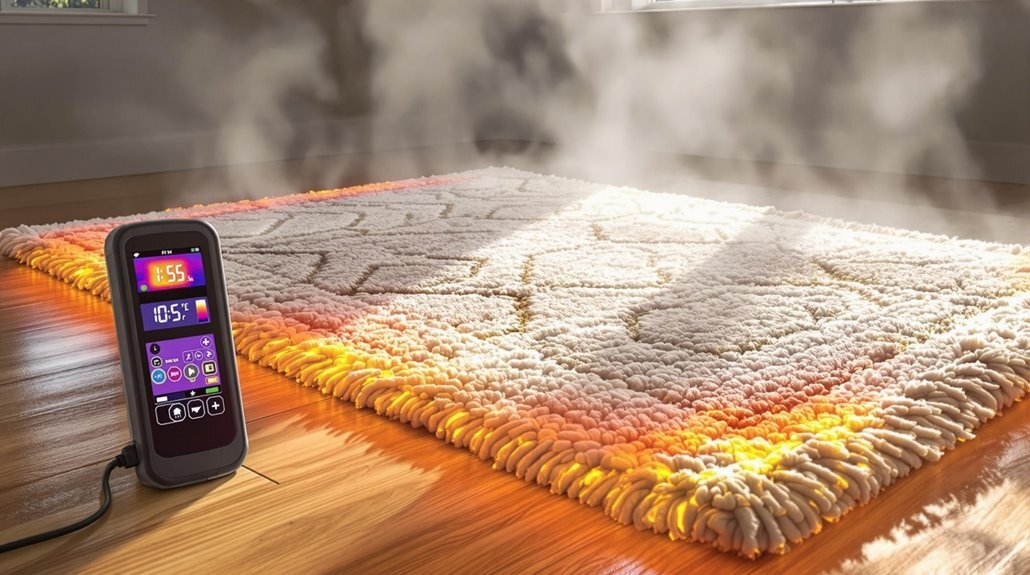
When it comes to pairing rugs with underfloor heating, selecting the right material is essential for both comfort and system efficiency. As a specialist in underfloor heating systems, I’ve found that natural fibers are your best choice for maintaining ideal heat transfer while protecting your investment.
Wool rugs are particularly suitable for underfloor heating systems. They’re naturally heat-resistant and offer excellent insulation properties that won’t compromise your heating efficiency.
If you’re looking for alternatives, jute and bamboo rugs are also great options, as they allow heat to pass through effectively while maintaining their structural integrity.
You’ll want to avoid synthetic rug materials at all costs. Materials like polyester, polypropylene, and nylon aren’t suitable for underfloor heating as they can melt or become damaged from prolonged heat exposure.
These materials also tend to have poor heat conductivity, which can reduce your system’s effectiveness and increase your energy costs.
When selecting your rug material, pay attention to the backing as well. Choose rugs with hessian backing rather than felt or synthetic alternatives, as these can act as thermal barriers.
If you need an underlay, opt for natural, breathable options that won’t hinder heat transfer. The key is to maintain low thermal resistance throughout all layers of your rug setup.
Remember that the right rug material isn’t just about aesthetics – it’s about ensuring even heat distribution and protecting your underfloor heating investment.
Natural fibers will give you the best performance while maintaining the efficiency of your heating system.
Rug Thickness Limits for Heated Floors
Thickness plays an essential role in determining whether a rug will work effectively with your underfloor heating system. At Floor Heating Today, we’ve found that the ideal rug thickness shouldn’t exceed 25mm to guarantee proper heat transfer. This measurement is vital because thicker rugs can create an insulating barrier that prevents warmth from reaching your room effectively.
When selecting a rug, you’ll need to take into account its tog rating, which measures thermal resistance. We recommend choosing rugs with a tog rating of 2.5 or less. This includes any underlay you might use beneath the rug. For instance, if your underlay has a tog rating of 0.8, your rug shouldn’t exceed 1.7 to maintain efficient heating performance.
Rug thickness can greatly impact different flooring types. If you’ve got wooden floors, you’ll need to be particularly careful, as thick rugs can trap heat and potentially damage your flooring. We’ve seen cases where excessive rug thickness has led to heat spots and even delamination in engineered wood floors.
For tiled floors, you’ve got more flexibility, but the thickness guidelines still apply. To guarantee ideal performance, look for rugs with a pile height between 10-15mm. Natural fiber rugs with hessian backing typically work best, as they offer better heat transfer than felt-backed alternatives.
How to Properly Place a Rug on Underfloor Heating
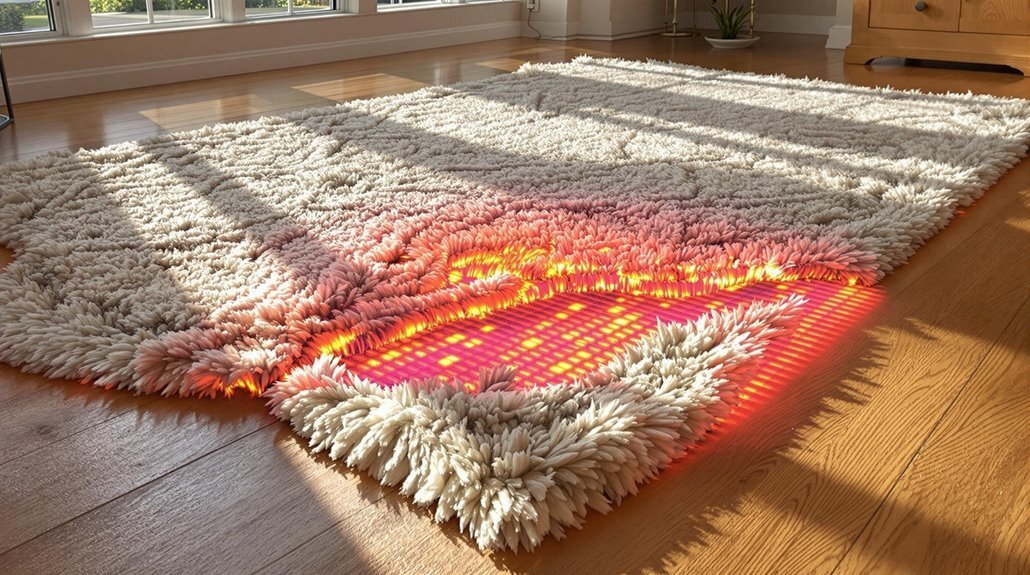
In our years of experience at Floor Heating Today, we’ve found that strategic rug placement makes all the difference in maintaining your underfloor heating’s efficiency. When you’re considering where to position your rugs, there are several vital factors you’ll need to keep in mind to prevent potential issues with your heating system.
First, you’ll want to avoid placing large rugs that cover extensive areas of your heated floor. Instead, opt for smaller or medium-sized rugs that allow proper heat distribution throughout the room. This approach helps prevent thermal blocking, which can reduce your system’s effectiveness and potentially damage your flooring.
When it comes to specific placement, keep your rugs away from areas that receive direct sunlight. This is particularly important if you have wooden flooring, as the combination of underfloor heating and sun exposure can cause the wood to warp or twist.
You’ll also want to guarantee there’s adequate airflow around the rug’s edges to prevent hot spots from forming.
If you’re working with wooden floors, it’s critical to monitor the temperature beneath your rugs. We recommend keeping the temperature below 27 degrees Celsius to protect your flooring from damage.
Before finalizing your rug placement, consult with your flooring supplier to understand any specific requirements or limitations.
Remember to periodically check under your rugs for signs of heat damage or discoloration. If you notice any issues, you may need to adjust the rug’s position or consider using a different size or material to maintain ideal heating performance.
Maximizing Heat Efficiency When Using Rugs with Underfloor Heating
Every aspect of your rug selection impacts the efficiency of your underfloor heating system. When you’re choosing rugs for heated floors, it’s essential to understand how different materials and thicknesses affect heat distribution throughout your space.
For ideal heat efficiency, you’ll want to select rugs with a thermal resistance of less than 1.5 togs. Natural fibers like wool, cotton, and jute are excellent choices as they offer good heat conductivity while maintaining breathability.
If you prefer synthetic materials, opt for low-pile options that won’t trap heat beneath their surface. The thickness of your rug plays an important role in maintaining heating efficiency. We recommend selecting rugs between 10-15mm thick, as they provide the perfect balance between comfort and heat transfer.
Anything thicker than 25mm can create an unwanted insulation barrier, forcing your system to work harder and increasing energy costs. Your rug’s backing material is equally important. Choose rugs with hessian backing rather than felt, as felt can greatly reduce heat transfer.
When it comes to rug pads, avoid standard rubber or foam options. Instead, invest in specialized heat-friendly pads designed specifically for underfloor heating systems. Size also affects efficiency – smaller rugs are generally better than large ones that cover most of the floor.
They allow for better heat circulation and don’t create extensive insulation barriers. By strategically placing smaller rugs in specific areas, like under coffee tables or in seating areas, you’ll maintain ideal heat distribution while still enjoying the comfort and style that rugs provide.
Safe Flooring Options for Combining Rugs and Underfloor Heating
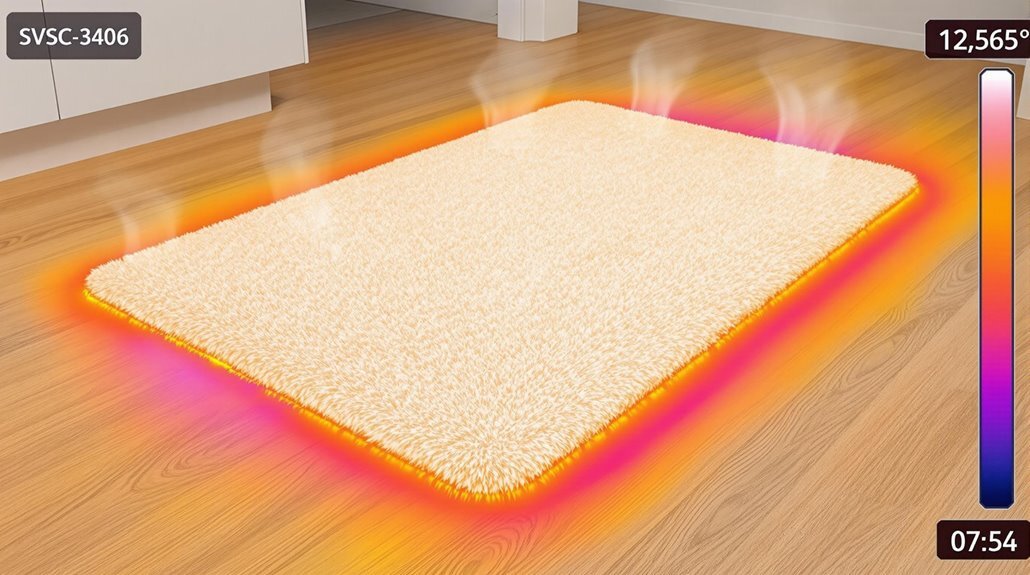
While choosing rugs for your underfloor heating is important, selecting the right base flooring material is essential for peak system performance. At Floor Heating Today, we’ve found that certain materials work exceptionally well with underfloor heating systems, while others can cause significant problems down the line.
Tile flooring and microcement are your best options, as they conduct heat efficiently and maintain consistent temperatures up to 29 degrees. Engineered floorboards and laminate flooring also perform well due to their layered construction, which provides stability against temperature fluctuations.
When you’re planning to use rugs suitable for underfloor heating, these base materials will guarantee ideal heat transfer through your chosen floor coverings.
Here are the top considerations for combining flooring materials with underfloor heating:
- Natural fibers like cotton and wool work best for both flooring and rugs, maintaining heat efficiency while preventing damage.
- Confirm any floor covering, including rugs, doesn’t exceed the maximum thickness of 25mm to maintain proper heat distribution.
- Avoid solid wood flooring, as it’s prone to warping and can compromise your heating system’s effectiveness.
For concrete floors, you’ll get excellent results with hydronic heating circuits embedded directly in the slab. This combination provides superior thermal mass and reduces heat loss, making it an ideal foundation for any additional floor coverings you might want to add later.
Remember that whatever flooring material you choose, it should support both your heating system’s efficiency and your desired aesthetic outcome.
Get Your Floor Heating System Installed by Pros
Choosing the perfect rug for your electric underfloor heating system ensures comfort without compromising efficiency. A suitable rug, ideally made from natural fibers, promotes even heat distribution while avoiding overheating risks. Unlike a radiator, underfloor heating provides consistent warmth, but selecting the type of rug that doesn’t trap heat is essential. Always choose a rug with a low tog rating to maintain performance.
Ready to upgrade your heating? Floor Heating Today offers expert installation services in Sydney. Contact us now for a consultation and experience the best in underfloor heating!


